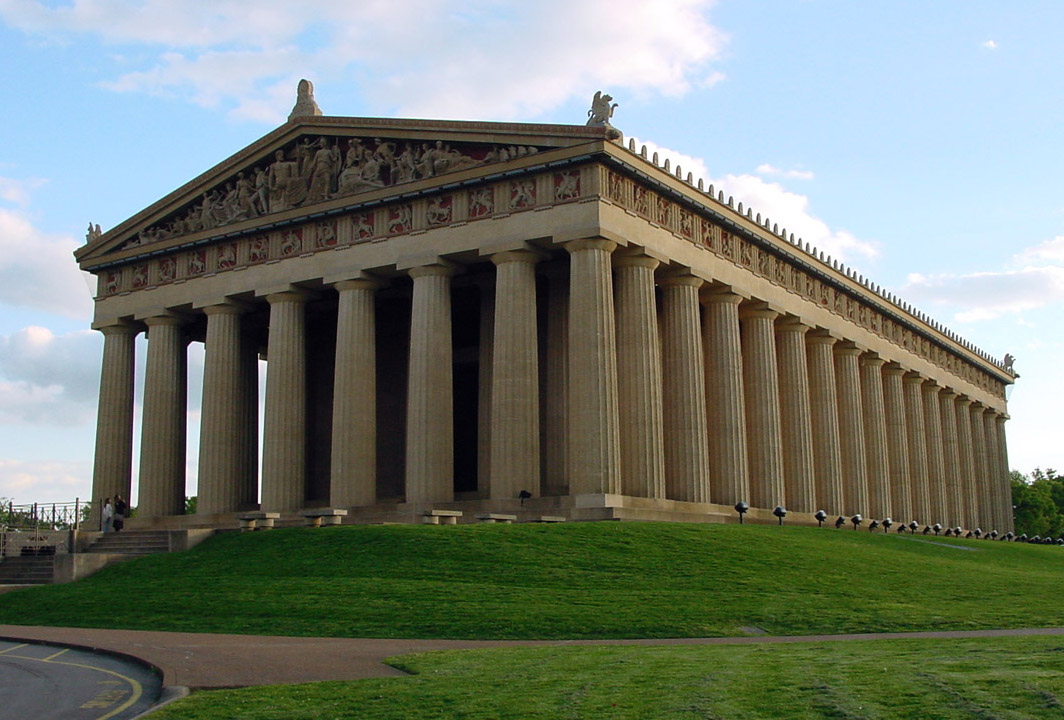- Centennial Park (Nashville)
Infobox Park
park = Centennial Park
image size = 250px
caption = The Parthenon is the centerpiece of the park.
type = Public park
location =Nashville, Tennessee
coordinates = coord|36.149|-86.812|display=inline
size = convert|132|acre|km2|sing=on
opened =
operator = Metropolitan Nashville Department of Parks and Recreation
visitors =
status =Centennial Park (Nashville) is a large urban
park located approximately two miles (three km) west ofdowntown Nashville, Tennessee , across West End Avenue (U.S. Highway 70 S) from thecampus ofVanderbilt University and adjacent to the headquarters campus of theHospital Corporation of America .The convert|132|acre|km2|sing=on park was originally farmland which was turned into the state fairgrounds after the Civil War. From 1884 to 1895, the site served as a racetrack and was known as West Side Park. In 1897, it was the site of the
Tennessee Centennial and International Exposition and was renamed Centennial Park. After the exposition ended, most of the building and exhibits (with the exception of a full-scale model of the Athenian Parthenon) were dismantled, leaving in its place a landscaped open area with a small artificiallake (named "Lake Watauga" after the region in westernNorth Carolina where many of Nashville's early settlers moved from), sunkengarden s, and a bandshell. This area became an important recreation site for white Nashvillians; "Jim Crow" laws forbade its use byAfrican Americans until the 1960s, which resulted in disagreements which led to the closure of the park'sswimming pool because it was filled in with dirt in order to prevent it from being integrated. The filled in pool was subsequently reopened as anart s center.The Parthenon replica, built largely out of plaster as a temporary exhibit building (the Nashville pavilion of the Centennial Exposition) began to fall into disrepair and was proposed for demolition on several occasions, but public sentiment in favor of this symbol of Nashville as the "Athens of the South" precluded this. Finally, in the 1920s it was agreed to replace the temporary plaster building with a permanent,
concrete andsteel replacement which remains today and has been refurbished on several occasions. It functions today primarily as anart gallery . It contains a statue of Pallas Athena, said to be the largest indoor sculpture in theWestern world , which was commissioned by the city and realized by the renowned Nashville sculptorAlan LeQuire . Owing to the completeness and the multiple color surface painting (calledpolychrome ), this replica is arguably closer to what the Athenians saw than are the current ruins inAthens .From 1954 to 1967, the Parthenon was the backdrop for an enormous
nativity scene sponsored by the now-defunctHarvey's department store. The scene was approximately convert|280|ft|m long, convert|75|ft|m deep and was flooded with colorful lights. However, the Italian firm from which the Harvey family had purchased it went out of business soon afterwards. Hence, no authorized repairs, technical support, or even reliable guides to proper maintenance of the fixtures were available. By 1968, the fixtures were in such serious disrepair the nativity could not be exhibited. Financial responsibility became too much for Harvey’s and the city of Nashville and the scene was sold to aCincinnati shopping center. According to the "Nashville Banner ", the nativity scene was shown only two Christmas seasons in Cincinnati before it collapsed and was discarded.Centennial Park is the site of the climactic scene in
Robert Altman 's "Nashville", a picture beloved of manyfilm critic s.There were many mature shade trees in the park until the
1998 Nashville tornado outbreak ; most of them were damaged or destroyed in the storm. The park was also the site of the storm's sole fatality, a Vanderbilt ROTC cadet. Since then, the park and other areas of outdoor gathering in the Nashville area have been equipped with storm-warning sirens.On
November 11 ,2005 , Centennial Park became Nashville's first wireless internet park by offering freeWi-Fi internet access to park patrons.The park also contains a recreation center and is the home of the administrative offices of the city's Department of Parks and Recreation.
References
*cite book | author= Johnson, Leland R. | title=The Parks of Nashville: A History of the Board of Parks and Recreation | location=Nashville | publisher=Metropolitan Nashville Board of Parks and Recreation | year=1986 | id=
Wikimedia Foundation. 2010.
